by meghanleborious | Jun 30, 2020 | Notes on Practice
I lost my way into the writing for a moment.
I just didn’t know what to say. Or what I could say that would be relevant at this time. Just writing about my own personal practice seemed so self-centered, given all that’s going on in the world. And who am I to speak on matters of such grave import? Then again, who am I not to?
The only thing I’m an authority on is my own body–though even my body is riddled with the expectations and representations of the societies it exists in–and I hope this humble material can lead me to deeper wisdom, that extends beyond my own small experience.
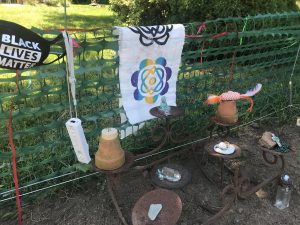 Nearly every day I bring the speakers outside and do the 5Rhythms dance and movement meditation practice on the grass in the backyard of my parents’ house, where my ten-year-old son, Simon and I are staying temporarily.
Nearly every day I bring the speakers outside and do the 5Rhythms dance and movement meditation practice on the grass in the backyard of my parents’ house, where my ten-year-old son, Simon and I are staying temporarily.
Most days I’m amazed that I can dance for over an hour, hard, totally on my own, and stay engaged, often joyful, sometimes fascinated, and sometimes even subsumed. Yesterday after a long wave, I lay down on my back and watched the few scant clouds move across the open sky.
In the morning, I was experiencing almost unbearable anxiety, to the point that I was pinched and dissociative. Whenever things are ok at work, I feel like I have it all figured out and it will be smooth from now on. But occasionally something will blindside me, as happened over the last few days.
I was managing the resulting feelings, but then I let myself drink too much wine, perhaps craving a break from anxiety, which put me over the edge the next day. I struggled to be present with Simon, and found it hard even to soften in a hug with him, which of course made me feel more anxiety, along with its near cousins: shame and guilt.
In the backyard, I stretched my legs briefly as Flowing music started. Then I replayed the same song when I got to my feet, calling my attention down, and bringing energy up from the ground. It took a lot of discipline and patience to even begin to settle in. By the second song, I was moving more freely and pulling in big lungfuls of air with each breath.
As the music moved into Staccato, I recalled a distant memory. It was very hot and part of my dance floor was in full sunlight, so I wore a baseball hat. When I first fell in love with dance, it was in underground clubs and parties in the 1990’s. The flashiest dancers in these venues were guys from the house music scene, with ultra-wide jeans and baseball caps; and this was where I cut my teeth.
I never wore a cap myself, but I picked up some of their gestures in mirroring and competing with them; and sometimes they rise up out of my body’s memory. I totally entertained myself with this, first playing directly with the cap, noting the gestures of my elbows, shoulders, hands and knees, the angularity that rose up, and the way of moving the diagonal planes of my body. Then I took the cap off and continued to play, watching my own shadow for information and entertainment. I thought about how I might teach this idea, or better, how I might use this idea as an example for how to tap into the body’s personal experiences as language for the narratives we create in moving.
The longest part of the wave was Staccato, and I settled in for a slow build on this hot, dry afternoon, visiting many of my favorite tracks, finding varied expression and enjoying increased flexibility and range of movement because of more time to stretch and do yoga lately. In one song, I lifted one leg up, open to the side, and experimented with spinning around like a young tap dancer I’d seen in a video. In another I turned my knees in, bouncing them together and raising my heels to the sides while I leaned forward and rocked my hooked elbows.
Chaos found me more tired than usual. Because of anxiety, I’d only slept a few hours the previous night and it was starting to catch up to me. I sunk low into my hips during a track that straddled Staccato and Chaos, whipping the spine from the hips through the crown of the head. Instead of expanding into the rest of the yard during Chaos, as often happens, I stayed relatively close to my little dance floor, a blue outdoor rug, but still allowed myself to move vigorously, releasing the head and trying to let go of the stories that were plaguing me.
In Lyrical, I moved with relief, grateful for release from the anxiety I started with.
New factors kept triggering anxiety, though. It wasn’t until today when I went for a run in the woods and danced by a river, with the first rain of two weeks blurring the edges of everything and falling in a soft hush, that I could see it as a gift–an opportunity to work with my patterns–even as the anxiety continued to spike with a rush of chemicals releasing in the diaphragm, then abating again.
I saw how I got tight and checked out when very difficult and painful feelings came up, not fully listening to Simon as he shared stories of his day, and unable to clean, organize, or communicate effectively. I saw how I hunched my shoulders, crinkled my forehead, and shortened my breath. I saw how I had used alcohol to help me escape, but only succeeded in making the feelings more painful.
I also saw how intensely I wanted the discomfort to end, but recognized that I could not avoid the process of reckoning that was unfolding, and determined to let it run its course.
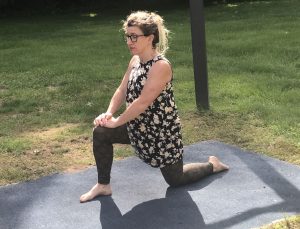 On days when I’m not dancing to music in the backyard, I’m dancing alone by the river, without music. Sometimes these waves are brief, as I often feel the pull of responsibilities at home.
On days when I’m not dancing to music in the backyard, I’m dancing alone by the river, without music. Sometimes these waves are brief, as I often feel the pull of responsibilities at home.
Today, I moved on a patch of loose sand in the middle of the path by the river. A roof of leaves mostly sheltered me from the rain, but the drops that filtered through landed on my exposed face and arms. Concentric circles from the raindrops intersected on the surface of the river. Beginning to move in circling motion, the sand churned up under my feet. Again, it took me some time to settle into awareness of the feet. Stories kept sparking and often ran for many seconds before I directed attention back to the feet, circling, and breathing in.
Staccato broke through before I actually noticed it and I explored warrior cries, delivered at different volumes and heights. Chaos came and went many times, even twice dipping me back into Flowing. In its third peak, I danced some kind of demon, my vision totally blurred, and an ardent, warp-speed side-to-side stomping that I’ve never experienced before came through. Then I leaned forward and held my arms wide and straight out, bouncing from foot to foot, my head released, in a low, weighted spin.
Then my field of vision expanded beyond the small area I was focused in. “Yes,” I said quietly, noting the green light of far away trees, the moving river, the white sky. I continued to move, more quietly now, stories still occasionally sparking but less compelling, moving closer to the river and exploring different contours of the path.
Again, it amazes me that even without music, on most days I can dance for long stretches, essentially self-generating. That as much as I’ve loved dancing in big, sweaty, loud crowds, as much as I’ve hung on the words of cherished teachers, in the end, the practice can be stripped to its bones: that a secret to being fully alive is movement, that, as Gabrielle Roth, the founder of the 5Rhythms practice said, “A body in motion heals itself.”
Eventually, movement quieted further, and I decided to do another loop of the trail in walking meditation before running back home. As before, stories kept sparking, especially ideas for how to fix the situation that was causing anxiety. But I kept returning the attention to the feet, the sponginess of my sneakers, and the sticks, rocks, grass, and soft dirt under me, noting, too, as attention shifted, tension in my jaw, water droplets on the river, a tight shoulder, a bird on a nearby branch, and again and again, the stories that kept trying to hijack me.
I still don’t know what to say, or where to begin. But I think sometimes you just have to step in, and let the world lead you.
June 26, 2020, Broad Brook, Connecticut
This blog consists of my own subjective experiences on the 5Rhythms® dancing path, and is not sanctioned by any 5Rhythms® organization or teacher.
by meghanleborious | Jun 11, 2020 | Notes on Practice
I would like to open with an apology.
This is an apology for all the ways that I’ve benefitted from White privilege, for all the things I’ve wittingly or unwittingly done to sustain systems of oppression, for all the times I’ve made myself separate and superior from another human being in my mind, for all the times I’ve been insensitive or ignorant in thought or in speech, for all the times I’ve congratulated myself on being a not-racist without really thinking through or understanding what that might mean, for all the times that I have hurt, disregarded, dismissed or in any way harmed a person of color.
I’m sorry. 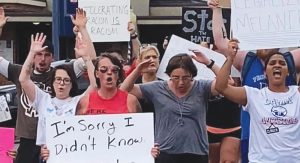
It is not the responsibility of any Black or Brown person to accept this apology, of course, but I offer it in case it somehow matters.
I remember a time, one of many, when I was taken apart in a conversation by a person of color. He challenged me to both act to end racism, and to be sure to act with precision and sensitivity. He also challenged me to get past my own ego so I would be able to see more clearly.
On the note of letting go of ego—I thought about an incident that took place during a meditation retreat I was staffing several years ago. We were sitting on meditation cushions in a group of ten, engaged in a formal discussion about aversion—the Buddhist concept of pushing away what is unpleasant or uncomfortable.
In response to a comment about the aversive energetic shell humans create to keep ourselves safe, I said, “Well, you know. It would be one thing if creating a shell actually worked to make us happier or keep us safe. The thing is that it really doesn’t work. If it did I would be all for it, but it doesn’t.” I’m not exactly sure how it was framed, but I said something about, “It’s not like it’s the subway in the South Bronx at 2AM in the 1980’s, when you might actually need a shell around you.”
A flash of raw anger shot around the circle; and every single person felt it before even a word was said. One woman spoke up, expressing that what I said was racist.
Man, that hurt. Shame of the most intense possible quality flooded me. My heart started beating like crazy. My partner of many years at the time was a Black and Latino man. We had shared hundreds of hours in discussion about racism, ranging through many different levels. Secretly, I had always been terrified that on some deep level I was actually a racist. Though I was afraid, I approached the woman during the next break and asked her to talk with me about her feelings. She was receptive; and after, I understood how she could see my comment as racist.
This terribly painful experience gave me great insight; and a rush of relief flooded me with another set of powerful chemicals. I realized I had been afraid that there was some essential part of me that was racist. Every other *essentialist part of my psyche had been rigorously interrogated, but this part remained hidden, obscured by shame and fear. I realized that just as there is no essential self; too, there is no essential racism. As I currently understand it, racism is a process—a process that affects every single person who lives in this culture. Fundamentally, it is our flawed human tendency to separate the world into “us” and “them” that lays the foundation for racism, not an intrinsic hidden evil; though there is no denying the virulent intensity and complexity of racism as it now functions.
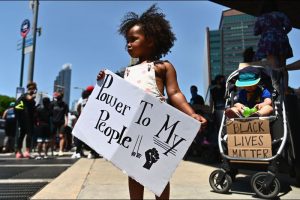 This understanding of racism as a process helps me to feel like improvement is possible. Rather than overcompensating to make up for my inner fear that I’m a racist, or getting defensive and unable to listen and learn, or stepping onto a liberal soapbox, I can then humbly recognize that I have a lot to learn and set about learning it.
This understanding of racism as a process helps me to feel like improvement is possible. Rather than overcompensating to make up for my inner fear that I’m a racist, or getting defensive and unable to listen and learn, or stepping onto a liberal soapbox, I can then humbly recognize that I have a lot to learn and set about learning it.
It would be impossible to overstate the importance of these insights for my personal path; and I am deeply grateful to the woman who called me out. Even my firmly-held idea that I was a not-racist was limiting my perception of reality, and, as such, needed to be interrogated, as much as any other part of me, in the interest of uncovering the deepest truth and the cognitive biases that block me from seeing the truth.
From a practice perspective, so much of my training–both in meditation and in the 5Rhythms dance and movement meditation practice–has been about building up the capacity to stay with discomfort. Being able to stay with discomfort, rather than doing the infinite things we do to try to escape it, is a key skill for being able to encounter ourselves and others in a meaningful way, and to interrogating even the deeply guarded biases that keep us ignorant.
Being able to stay with discomfort also seems like a key skill in this moment of reckoning, of examining and challenging four centuries of racism and oppression in America.
On a different day, I might have found a way to rationalize or diminish my fellow participant’s outrage, but thankfully this time my practice training served me and I was able to stay with discomfort, in this case agonizing shame, to engage in a process of inquiry.
Moving forward, I am a committed White ally to Black and Brown people, and an activist for social justice. I acknowledge that in stepping up, I will sometimes misunderstand and get it wrong. I promise to listen with receptivity, especially when I have misunderstood and to do my best to repair any harms I cause. But I won’t let my fear of messing up or of seeming like a racist or of stepping on someone’s toes keep me from acting and from stepping up in the best way that I can.
I step up not as an authority whose opinion has special weight because of the color of my skin, but as a humble collaborator, to examine my own biases, and to partner in the critical work of dismantling the structures of oppression in our hearts, minds, institutions, and policies.
Our humanity is at stake now. It’s the least I can do.
*As you probably know, from the perspective of some Buddhist philosophy “essentialism” is the belief that there is a separate and definable “self” and too, implies that reality has some logical coherence or definability.
Photos: lakeviewnews.com, nydailypost.com
This blog consists of my own subjective experiences on the 5Rhythms® dancing path, and is not sanctioned by any 5Rhythms® organization or teacher.
by meghanleborious | Jun 6, 2020 | Notes on Practice
I’m on a train headed home after a late night out in NYC. A man halfway down the train is trying to catch my eye. There are 20 or so people on the train, all of them apparently people of color except the one white man who is trying to catch my eye.
I didn’t have language for this kind of experience until I saw a retrospective of the artwork of Adrian Piper at the New Museum in 2000. Piper is a Black artist who was often mistaken for a White person. She created small index-size cards that start with the text, “Dear Friend, I am black. I am sure you did not realize this when you made/laughed at/agreed with that racist remark…” She handed the cards out when White people mistook her for a White person and tried to team with her, setting Black people up as an “other” and making racist remarks. I love to picture her handing these out, for example on the subway.
Perhaps like this man, who seemed to be trying to connect with me for the simple reason that we were the only two White people on the train, perhaps trying to team with me to create an affinity that made him feel like he was separate, different from the rest of the train riders.
***
My core personal practice is the 5Rhythms dance and movement meditation. Normally, I dance in a 5Rhythms class once or twice a week and occasionally on my own, but since the start of the pandemic, I dance a 5Rhythms wave every day. To dance a wave is to move through each of the 5Rhythms–Flowing, Staccato, Chaos, Lyrical, and Stillness–in sequence.
Yesterday, I felt disheartened and lethargic. The coverage around the murder of George Floyd swirled around in my head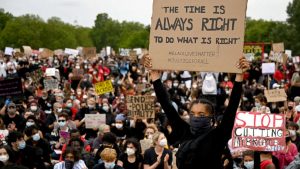 and I kept having ideas for things I should do, actions I should take. Memories, regrets, insights, and bits of speeches mixed in my head with the recent reporting.
and I kept having ideas for things I should do, actions I should take. Memories, regrets, insights, and bits of speeches mixed in my head with the recent reporting.
I danced a lone 5Rhythms wave in the woods, on the bank of the Scantic River. I couldn’t get traction until I started to move with full attention to the breath in each rhythm.
In Flowing, I drew air in, emphasizing the inhalation, filling my lungs, letting in as much air as I could take, allowing my body to move in response, circling as the breath fell out. I didn’t think Staccato would be available, but after a time in Flowing I suddenly shifted attention to the outbreath, exhaling with force, pumping my belly, sinking into the knees, exploring the points of the elbows. In the rhythm of Chaos the breath got choppy, sometimes gasping, sometimes fast, sometimes with a forceful exhalation, sometimes briefly held, defying regularity. In Lyrical, the breath stayed just as unpredictable, but got much quieter and softer. In Stillness, the breath was elongated, and also seemed to be coming into and leaving the body through the pores.
Today, after a full day of working remotely and spending time outdoors with my ten-year-old son, Simon, I decided to set up speakers and dance a wave in the backyard of my parents’ house, where Simon and I are temporarily living.
Before I started, my mom took a picture of me taking a knee, a gesture inspired by NFL football player Colin Kaepernick’s controversial action of taking a knee before a game to acknowledge the continuing deaths of Black people at the hands of white police officers, and to express support for the Black Lives Matter movement. I planned to post the image in my school community.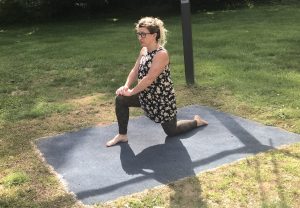
I remembered something that happened in a classroom several years ago. I was co-teaching with a Black Haitian-American woman; and the class was entirely composed of Black and Brown high school students. Something we read led a student to express anger about White people and their racist actions.
Everyone cringed a little and looked at me. I was the only White person in a room of 20 or more people, and they thought I would take it personally. “Guys, listen. Don’t worry about me. Seriously. I am just one White person in a roomful of Black and Brown people. It is totally ok if I’m uncomfortable. Sometimes things come up that might make me feel uncomfortable. I won’t die from being uncomfortable. Everyone should feel free to discuss their feelings and opinions here.”
Looking back, it’s crazy that just one White person could have so much impact–a manifestation of White privilege. Back then I didn’t have that language, but I knew what was happening felt wrong, and that I didn’t deserve to have so much impact on the discussion. If I didn’t think to say what I said, I wonder how many voices would have been silenced? I wonder how many children of color in classrooms with White teachers do feel like they have to temper what they say, to hold back their opinion, to account for the sensitive teacher’s White fragility and inability to cope with discomfort? Thank God I had the insight and courage to speak this time. I wonder how many other times I haven’t even noticed?
So much of my practice and my training, both in meditation and in 5Rhythms, has been about building up tolerance to discomfort, being able to stay with what whatever is happening, rather than trying to escape it–in this case it would have been at the expense of discounting and silencing many young voices. It this willingness to be with reality that is needed now, even if it is uncomfortable or painful, as we interrogate the internal and external structures that sustain oppression.
I remembered another classroom incident, this one more recent. A student reacted to a phrase in Amy Tan’s “Joy Luck Club,” when Chinese American character Jing-Mei’s mother says, “You look like Negro Chinese.” Hearing the passage, the student raised his hand and said, “That seems kinda….racist.” My co-teacher minimized his feelings. “Oh, no, that’s not really racist, it’s just…”
I don’t even know if you would call this gaslighting because she seriously believed her position. To be fair, she is one of the most dedicated educators I know, and believes she has devoted her life to helping young people. And I guess it’s possible she was trying to protect the student from discomfort or pain. It’s also possible she wanted to avoid discomfort, or that she was just unable or unwilling to see it.
Either way, the student closed his mouth, tightened his jaw, and folded his arms in front of him–even after I indignantly protested. What would a lifetime of experiences like that do to you? What does a lifetime of experiences like that do to you?
***
In contrast to yesterday’s wave, today’s was loud, energetic, and messy.
A blaring fire siren went off while I moved in Flowing, so I moved with its urgency along with the patient, circling track.
Today, I had less difficulty than yesterday with the rhythm of Staccato–for me the most variable of all the rhythms. I moved easily, gearing up with purpose. My feet were alive and expressing minute shifts of balance and force. My shoulders came alive and I expanded my zone, taking up more and more space, hopping, double hopping, sometimes adding a punctuated jump up. I was way in a cut, then suddenly the song tore me up and I was sobbing, snotting, thinking about the state of things, and praying to see reality clearly. Ideas for action kept jumping to mind. I needed several staccato tracks today, and went through a huge range of emotions, including anger and growling ferocity during one energetic song.
Chaos kept sneaking in all along, and when it finally broke out in full force, I flung my head around in weighted spinning, sinking low and keeping my arms alive and defiant. I cried more, grateful for the chance to discharge some of the powerful emotions coursing through me.
Lyrical started out extremely fast, at 173 beats a minute. I tried to dance to every single rhythm, melody, and sound, an impossible but engaging attempt.
I moved for some time to the currents in the air even after the music stopped, reverent.
As a White person, my role now is to be a ferocious advocate and a humble collaborator, in service to justice and dignity for all people, for my own child and for every mother’s child.
It’s the least I can do.
“My humanity is bound up in yours, for we can only be human together.” –Desmond Tutu
This blog consists of my own subjective experiences on the 5Rhythms® dancing path, and is not sanctioned by any 5Rhythms® organization or teacher.
by meghanleborious | Jun 1, 2020 | Notes on Practice
Like many, I’ve been preoccupied with the killing of George Floyd and the protests across the nation.
As throughout the pandemic, I continue to do the 5Rhythms dance and movement practice and to meditate, sometimes multiple times a day.
Yesterday, I had a video call with a group of students; and we discussed the unfolding events in Minneapolis. One student said, “It’s like it was me.” Several students agreed with her. We discussed how among the last words of George Floyd were “I can’t breathe,” and how symbolic that is.
Today, I went for a run. My favorite place to run is in the woods along the Scantic River, near my parents’ house, where my ten-year-old son, Simon, and I are temporarily living.
I felt the hush of the shade canopy as I turned off the road, with the trees, plants, and animals moving fast toward the full expression of summer. The river was low and muddy; and beaches that are usually hidden by the water were revealed. I stretched through each stride, and ran fast enough for breath to be foregrounded in my awareness. I was alone in the woods, except for two white men I passed who were sort of leaning on a pickup truck, socializing.
I started looking for a good place to dance a wave, which is to move through each of the 5Rhythms–Flowing, Staccato, Chaos, Lyrical, and Stillness–in sequence. I noted a lovely river beach, revealed by the low water-line, in a grove bordered by gnarled roots.
I also noticed a path snaking along the water that I had never seen before, as it was concealed by the grass next to the main path, and most of the time is under the water level. I thought about how this moment has revealed things that are often hidden, the deep roots and vast reach of racism coming above the surface at this time.
I’m raised by deeply committed, practical activists who serve on multiple local councils and committees. I shared their belief in democracy, incrementalism, and Dr. Martin Luther King, Jr.’s idea “the arc of the moral universe is long, but it bends toward justice.” I wasn’t deluded about the continuing ravages of racism on American society, but I really believed that, little by little, things were improving.
That was, until Donald Trump was elected in 2016. Despite countless appalling and egregious abuses against people of color, women, immigrants, and differently-abled people in his personal history and during his campaign.
I started to come to terms with the fact that it wasn’t just despite these abuses, but in some cases because of these abuses that he was elected.
And suddenly I had to come to begin to come to terms with an agonizing reality I hadn’t been able to see. And to come to terms with the layers of internal bias, and layers of white privilege that I personally benefit from, including the fact that I couldn’t actually see just how bad it was.
Don’t get me wrong. I love my country. This country is not solely defined by Donald Trump and the white nationalists he associates with. It is also my country, my progressive parents’ country, the country of countless activists, visionaries, and extraordinary children of color who are rising up into their own power as we speak, including the teens I teach, and my own ten-year-old child.
Back to my run in the woods, and my search for a good place to dance.
I love picking inspiring places to move, and this little beach was calling me. The only problem was that I was slightly visible through the trees to the two men by the pickup truck. I told myself they could barely see me, and that I could just stay a bit to the side.
Beginning to move in Flowing, I dared to take my shoes off. My feet released on the packed sand, but I remained wary. I stayed in the rhythm of Flowing for a long time, trying to settle in. Throughout, I remained preoccupied with the unfolding events in Minneapolis and other cities. Segments from news stories filtered through my mind. The president’s thinly veiled racist comments. The image of George Floyd, dying under a nonchallant officer’s foot. Activists, leaders, and commentators’ perspectives.
 I understand the desire by black protestors to protest, and in some cases to riot, recalling the words of Dr. Martin Luther King, Jr. “A riot is the language of the unheard.” But another developing angle was that in Minneapolis reportedly a lot of the protesters who were looting and inciting riots were actually from out of town and were white supremacists.
I understand the desire by black protestors to protest, and in some cases to riot, recalling the words of Dr. Martin Luther King, Jr. “A riot is the language of the unheard.” But another developing angle was that in Minneapolis reportedly a lot of the protesters who were looting and inciting riots were actually from out of town and were white supremacists.
My mind struggled to find a way to integrate all of this information.
I couldn’t fully gather myself, and I kept wondering about the men by the pickup truck. If they came after me, what would happen if I screamed? Would I be able to talk them out of an attack? I wondered if they were Trump supporters? And what if they thought this kind of dancing was weird and they wanted to attack me? I tried to talk myself out of it. Probably they were perfectly nice. This is a small town, they couldn’t risk raping or killing me because it would be easy to figure out who they are. I noticed the soles of my feet on the ground, I sunk my weight low, and I moved in arcing circles, but still fear kept sparking.
And I am a white woman, who benefits from the privilege of being white. I kept imagining what it might be like for a person of color, to bear this kind of fear and more, not knowing if you could trust someone by the river, perhaps always wondering if someone’s internal hatred would incite them to violence, perhaps always feeling, on some level, unsafe.
I moved into the rhythm of Staccato, lately so available, but today faltering, then started to break hesitantly through to the rhythm of Chaos.
Then, one of the men started clapping. Slow, punctuated clapping.
Maybe not for me? Maybe for me?
I thought then that it was crazy to be there without my shoes on. What if I had to run? I stopped the wave I was dancing and put my shoes back on. Quickly.
I moved down the river path, again connecting with Flowing, beginning with the feet, moving to the ankles, the knees, hips, spine, shoulders, elbows, and head. As I moved in this second round of Flowing, I mapped out an escape. I could wade across the shallow river, run through the trees and brush on the opposite bank, and tumble out onto the road if anyone tried to go after me, even if they threatened me with a gun.
I watched all of this. This explosion of fear. This developed escape plan. And part of me recognized that it is arising from my own psychology. And another part of me recognized that sometimes people do attack, sometimes fear is totally valid and necessary. Which is especially true if you are a black person in America. If you have watched people who look like you callously murdered. If someone in your family has been abused or killed by the police. My fear was real, and I kept empathizing with what a person of color might be feeling now, might feel at any time.
I moved into Staccato, still hyper-vigilant. At a certain point, I moved into a very energized state and started slaying invisible demons, but for most of the time, I stayed in a slow groove, trying to gather myself into some kind of storm, but unsure of how to direct myself.
Chaos was a nominal release.
Lyrical was brief.
In Stillness, I listened to the sounds of wind moving the leaves. Often, by this point dancing in the woods, I’m subsumed by the energetic world, but today I continued to be ready to run if necessary.
I sat down on the sand to meditate, allowing myself the space to sink in. I noted the many shifts of awareness, and that I kept coming back to the developing events in Minneapolis.
As a human being, I am heartbroken and concerned. As the parent of a child of color, I am enraged and afraid.
Watching news coverage of high energy protests in cities across the country, including in my own neighborhood, Fort Greene, Brooklyn, I pray for the safety of the protesters, I pray for the safety of my own child and of every mother’s child, and I pray for change.
I offered a talk to my students about how proud I am of them for the work they have done around empathy, for being able to take different perspectives, and while I was dancing realized an error in my timing.
This is the not the time to praise people of color for developing empathy and awareness of interdependence, but a time for all people, including people like me who benefit from white privilege, to demand change in our structures, and for racism, and its roots in the belief that human beings are separate and distinct, rather than unfathomably connected, to be interrogated in every heart and mind, and exorcised from our structures and policies.
In the words of one of our many great civil rights leaders, Dr. Martin Luther King, Jr. during his last Sunday sermon at the National Cathedral just days before he was assassinated, “The time is always right to do right.”
May 31, 2020
This blog consists of my own subjective experiences on the 5Rhythms® dancing path, and is not sanctioned by any 5Rhythms® organization or teacher.
(Photos from CNN.com and NBCNews.com)
 Nearly every day I bring the speakers outside and do the 5Rhythms dance and movement meditation practice on the grass in the backyard of my parents’ house, where my ten-year-old son, Simon and I are staying temporarily.
Nearly every day I bring the speakers outside and do the 5Rhythms dance and movement meditation practice on the grass in the backyard of my parents’ house, where my ten-year-old son, Simon and I are staying temporarily.  On days when I’m not dancing to music in the backyard, I’m dancing alone by the river, without music. Sometimes these waves are brief, as I often feel the pull of responsibilities at home.
On days when I’m not dancing to music in the backyard, I’m dancing alone by the river, without music. Sometimes these waves are brief, as I often feel the pull of responsibilities at home.
 This understanding of racism as a process helps me to feel like improvement is possible. Rather than overcompensating to make up for my inner fear that I’m a racist, or getting defensive and unable to listen and learn, or stepping onto a liberal soapbox, I can then humbly recognize that I have a lot to learn and set about learning it.
This understanding of racism as a process helps me to feel like improvement is possible. Rather than overcompensating to make up for my inner fear that I’m a racist, or getting defensive and unable to listen and learn, or stepping onto a liberal soapbox, I can then humbly recognize that I have a lot to learn and set about learning it. and I kept having ideas for things I should do, actions I should take. Memories, regrets, insights, and bits of speeches mixed in my head with the recent reporting.
and I kept having ideas for things I should do, actions I should take. Memories, regrets, insights, and bits of speeches mixed in my head with the recent reporting. 

 I understand the desire by black protestors to protest, and in some cases to riot, recalling the words of Dr. Martin Luther King, Jr. “A riot is the language of the unheard.” But another developing angle was that in Minneapolis reportedly a lot of the protesters who were looting and inciting riots were actually from out of town and were white supremacists.
I understand the desire by black protestors to protest, and in some cases to riot, recalling the words of Dr. Martin Luther King, Jr. “A riot is the language of the unheard.” But another developing angle was that in Minneapolis reportedly a lot of the protesters who were looting and inciting riots were actually from out of town and were white supremacists.